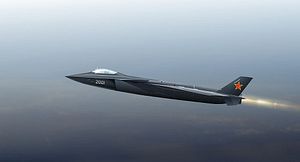The Chinese People’s Liberation Army-Air Force’s (PLAAF) fifth-generation Chengdu J-20 stealth multirole fighter is using a stopgap engine that reduces the jet’s planned performance profile, the South China Morning Post reported over the weekend.
The fighter, which is China’s answer to the U.S.-made F-35 Joint Strike Fighter, is now combat ready, per a confirmation by the PLAAF. The units that are currently in combat service, however, don’t use the Xian WS-15 (codename Emei) engine, which was designed for the J-20, SCMP notes.
Instead, the PLAAF J-20s in combat service now are using the Shenyang WS-10B (codename Taihang) engine, which is in use with China’s fourth-generation J-10 and J-11 fighters. According to mainland Chinese reports in 2017, the J-20 was meant to use the WS-15, possibly as early as 2018.
The Xian WS-15 has been in development for more than two decades, reportedly, and is an afterburning turbofan engine. At least one engine of the unit failed catastrophically during a ground running test in 2015, according to a source who spoke to SCMP, confirming the engine’s unreliability.
The PLAAF’s decision to retrofit early-run J-20s with the WS-10 for deployment in 2018 was driven by operational needs. The stopgap measure allows PLAAF pilots to begin combat training in J-20s, but will deprive these early J-20s of their ability to “supercruise” — fly at supersonic speeds without deploying the afterburners.
A diminished supercruise capability would hurt the J-20’s performance objectives, but the WS-10B engine may provide some stealth improvements over earlier WS-10 variants. Open source reports have seen a WS-10 variant, possibly the WS-10B that is in use on the combat service J-20s, that features stealth-enhancing serrated sawtooth edges on its afterburning nozzles.
The SCMP report would confirm longstanding rumors that concerns about a fast-widening air-to-air gap in East Asia spurred the PLAAF to hasten the J-20’s development. The United States delivered one variant of its fifth-generation multirole stealth fighter, the F-35B Joint Strike Fighter, to Japan already.
Moreover, the 12 U.S. F-35As, the conventional take-off variant of the fifth-generation U.S. fighter, are conducting regular operations from Kadena Air Base at Okinawa.
As my colleague Franz-Stefan Gady reported in January, PLAAF J-20As and Xian H-6K bombers participated in a combat drill in January. The drill was the first time the PLAAF confirmed that the J-20A had entered a combat exercise.
In its 2017 report on Chinese military power, the U.S. Department of Defense ascribed an important air-to-air capability to the J-20. “The PLA’s planned development of a fifth-generation fighter force will bolster its air-to-air capability,” the report noted.
“The J-20 and FC-31 are expected to feature high maneuverability, low-observability, and an internal weapons bay. Other key features include modern avionics and sensors that offer more timely situational awareness for operations in network-centric combat environments; radars with advanced tracking and targeting capabilities; protection against enemy electronic countermeasures; and integrated EW systems.”
The Pentagon assessed last year that the J-20 could enter service with the PLAAF as early as 2018 and would “significantly improve” its military aviation capability. The PLAAF has now confirmed that the J-20 is in service after the Chinese Ministry of Defense confirmed that the aircraft had been commissioned in September 2017.

































